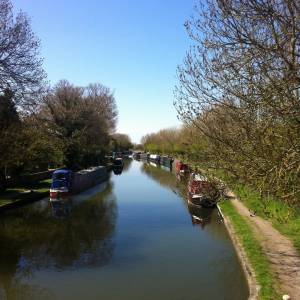
How to plan a #canal boat cruise
If you’ve not yet taken this year’s holiday the weather is now perfect for planning a canal boat cruise.
If you’re new to boating don’t overestimate the distance that you can travel. While 4 miles per hour is the agreed maximum speed, in reality you will travel slower than this, and will stop for locks, swing bridges, pubs and other attractions and distractions. It will take twenty minutes to work through a lock, and this could be longer if you find the lock in use when you arrive and have to wait.
To get the most out of your trip, plan ahead. You may like to plan which locations you will stop at for lunch or where you will moor overnight. Alternatively, some people like to be more flexible about where they will end up. On much of the canal network you can moor almost anywhere on the towpath but there are exceptions to this rule. It may not be possible to moor wherever you like on a tidal navigation. It is also impossible to moor in some inner city areas where the towpath is sometimes solid paving or concrete, with no mooring bollards or rings provided. The ‘off side’ of the canal, opposite the towpath side, is usually private land and therefore not available for visitor mooring.
An experienced narrowboater can handle a boat alone, however if you are new to boating you will find it easier with two or more adults on board. If your route includes a lot of locks consider traveling with extra crew, or travel as a pair with another boat. It is not safe for young children to assist with locks and they will need careful monitoring when the boat is passing through a lock, so bear that in mind when you plan how many adults are to be in your crew.
Your route may be completely rural and quiet, or include a particular town or city that you have wanted to visit. Popular canal guide books are published by Nicholson’s or Pearson’s and describe local restaurants, pubs and attractions as well as detailing the locations of locks and boater’s facilities.
When you’ve decided on your direction of travel and your ‘must see’ attractions, landmarks and towns, you will need to calculate how long the trip will take you and whether it is achievable in the time you have available. I use the Nicholson’s guide to count the mile markers en route, also counting the locks on the way. If you add the number of locks in your journey to the number of miles, and divide the end result by 3 you will have an idea of the number of hours the journey will take. (The ‘lock miles’ system works because a canal boat travels at roughly 3mph.)
Alternatively, get modern technology to do the maths for you. There are a number of canal route planners online. CanalPlanAC is an interactive online guide covering the inland waterways of Europe. It can be used to find local information such as pubs and shops. You can choose to assume a seven hour travelling day or select your own preferred travelling times. The results page displays a lovely aerial map (by Google) and an optional slideshow of photographs so that you can imagine your cruise.
Now all you need is a boat! Easily search within your budget range: Canal and narrowboats for sale.
Has your crew increased? Do you need to up-size to a bigger boat? Sell your current boat quickly and easily.
You may also like:
Living on a Boat: The Boatshed Guide (free) / Thinking of selling your boat? / Narrowboat interior second to none. / A slideshow of our boat of the moment./More articles.
New here? Follow our blog on Facebook or Twitter and share your waterways pictures and news.
Never miss an article: Sign up and get the latest blog articles sent directly to you.

